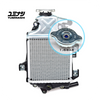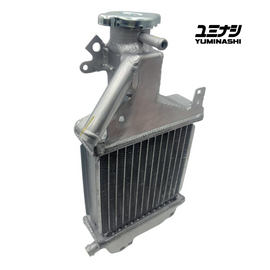RADIATOR SET WITH 1.6 BAR RADIATOR CAP
Brand : HONDA / YUMINASHI
- SKU:
- 19100-K40-160
- Availability:
- Fast moving item, ships the next day (Except on Sundays & Thai public holidays)...
- Weight:
- 982.00 Grams
- Minimum Purchase:
- 1 unit
- Shipping:
- Calculated at Checkout
 ● RADIATOR SET WITH 1.6 BAR RADIATOR CAP
● RADIATOR SET WITH 1.6 BAR RADIATOR CAP
● Genuine Honda radiator 19100-KZY-901 in a special combo with the 1.6bar Yuminashi/Nippon Denso radiator cap which can be installed on the 4-valves Honda Forza125, and the 2-valve eSP 125cc and 150cc scooters.
● Because a high compression engine always has a higher combustion chamber temperature than a stock compression engine, it's always a good idea to tune the cooling capacity from your engine together with the performance from your engine. If you don't balance this out, then it's possible to run in to an overheating engine.
A simple device like this 1.6 High Pressure Radiator Cap will help you to raise the boiling point seriously from your coolant and avoid your liquid to turn in to steam.
To understand this we need to give a short word of explanation about coolant (antifreeze) and the role of radiator pressure in general...
It might surprise you that the specific heat capacity of ethylene glycol–based water solutions (coolant) is less than that of pure water; in a 50 percent solution, ethylene glycol’s specific heat capacity compared with pure water is decreased at least 20 percent at 2°C (36°F) and about 17 percent at 93°C (200°F).
Propylene glycol, another common coolant, has an even lower specific heat so keep this in mind if you are working on a solution to fix your overheating problem.
Assuming a 100 gallons/minute coolant flow rate (378.5 liters/minute) and an energy loss through the coolant system of a certain horsepower, the water temperature increase would be 10 degrees, the ethylene glycol water mix would gain 20 degrees, and propylene glycol would gain 33.3 degrees.
Compensating for the reduced heat capacity of coolant/water mixes would require circulating more fluid through the system.
Assuming a fixed amount of circulating fluid and radiator capacity, running 100 percent water would be the most efficient coolant in terms of its ability to conduct heat with minimal temperature rise.
In other words, of all common liquids, water requires the most heat energy to change its temperature.
While the cooling capacity from water is higher, water is also corrosive and if you don't use a corrosion inhibitor when running pure water it will gradually eat away at seals and cause metal inside your engine to deteriorate so that's why we generally add antifreeze to distilled water to create the coolant we run in the bikes.
Antifreeze both keeps water from freezing in the winter (by lowering the freezing point of the water) and at the same time raises the boiling point of the water.
A 50/50 mixture as we typically use actually gives us a freezing point of -37°C (-35°F) and a boiling point of 106.1°C (223°F).
As the coolant gets hot it expands creating pressure in the system.
The hotter things get, the more pressure created.
The radiator cap allows pressure to build up in the cooling system and will eventually vent that pressure to the overflow bottle as the need arises.
The cap does this by a spring loaded valve which serves as a pressure relief valve at a rated pressure.
You’ll notice that there’s a plunger on the bottom of the cap. As pressure builds, it pushes up on that valve until eventually the valve is opened far enough for coolant to flow out of the tube connected at the radiator fill neck. It closes again when the pressure has dropped to the desired level.
This tank is there just to catch the coolant and store it until things cool back down, when a vacuum will be created and most of the coolant will return to the cooling system.
Pressure actually increases the boiling point of a fluid as you may know from high school physics class.
The pressure literally forces the liquid to remain a liquid longer and does not allow it to transform into vapor (steam).
All modern motorcycle cooling systems are under pressure and completely regulated by the radiator cap with stock 0.9 bar which is 13psi.
This special 1.6 high pressure radiator cap installed allows the pressure to increase from 0.9bar to 1.6bar or with other words from 13psi to 23.2psi.
How much does the pressure raise the boiling point? Well, it’s about 2-3°F for every psi that we increase the pressure of the system.
By using a stock 0.9 bar cap we make the average boiling point of a stock cooling system somewhere closer to around 120-121°C (248.3-250.3°F).
This is also the reason why your engine temperature warning light shows the red light at 120°C or 248.3°F because from that very moment on you start to produce steam which will eliminate your entire cooling system, with as result again a exponentially even hotter running engine, which end up in many cases with a bended cylinderhead and/or a leaking head gasket.
When we make a very easy change from a stock 0.9 bar cap to this 1.6 bar high pressure cap, we gain 0.7 bar or roughly 10.15psi of pressure, and means that you effectively get a buffer from around 15°C (25.4°F) extra which brings us on 134.3-135.4°C (273.7-275.7°F) before we might experience boiling coolant/steam in the system.
![]() SMART SHOPPER TIP:
SMART SHOPPER TIP:
※ BUYING MORE THAN 1 PIECE CUT THE TRANSPORT PRICE, AND YOU RECEIVE A 10% DISCOUNT ON TOP OF IT!
※ B2B:
- Purchases between 2 & 4 pieces of this product will receive a 10% DISCOUNT
- Purchases between 5 & 9 pieces of this product will receive a 15% DISCOUNT
- Purchases between 10 & 19 pieces of this product will receive a 20% DISCOUNT
- Purchases between 20 & more pieces of this product will receive a 25% DISCOUNT
- Click Here if you would like to know how to check the shipping fee for your order...

 Thai Baht
Thai Baht
 US Dollar
US Dollar
 Euro
Euro
 Pound Sterling
Pound Sterling
 Japanese Yen (¥)
Japanese Yen (¥)
 Australian Dollar
Australian Dollar
 Canadian Dollar
Canadian Dollar
 Russian Ruble
Russian Ruble
 Indonesian Rupiah
Indonesian Rupiah
 Malaysian Ringgit
Malaysian Ringgit
 Polish Złoty
Polish Złoty
 Czech Koruna
Czech Koruna
 Brazilian Real
Brazilian Real
 South African Rand
South African Rand
 Philippine Peso
Philippine Peso
 South Korean Won
South Korean Won
 Indian Rupee
Indian Rupee
 Vietnamese Dong
Vietnamese Dong
 Singapore Dollar
Singapore Dollar
 Hong Kong Dollar
Hong Kong Dollar
 CFP Franc
CFP Franc
 Swiss Franc
Swiss Franc
 Swedish Krona
Swedish Krona
 Turkish Lira
Turkish Lira









